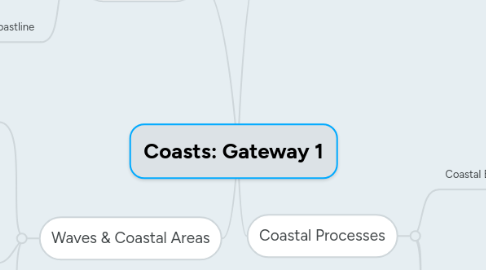
1. Wave Motion
1.1. Near the Coastline
1.1.1. - water is shallow & interacts w. seabed
1.2. Nearer the Coastline
1.2.1. - waves move into shallower waters - base slows down (FRICTION) - wave height increases, wave length decreases
1.3. Nearest the Coastline
1.3.1. - base of wave stops - wave crest becomes steeper, topples over - waves break on coast, releases energy
2. Waves & Coastal Areas
2.1. Waves on the Beach
2.1.1. Swash
2.1.1.1. - water that rushes up beach - carries sediments
2.1.2. Backwash
2.1.2.1. - swash that has lost energy (GRAVITY & FRICTION) - carries sediments from shore into sea
2.2. Types of Waves
2.2.1. Constructive Waves
2.2.1.1. - small, low waves - low wave height, long wave length - wave frequency: 6-8/min - strong swash, weak backwash - gentle coastal slope, sheltered coast
2.2.2. Destructive Waves
2.2.2.1. - large, high waves - high wave height, short wave length - wave frequency: 10-14/min - weak swash, strong backwash - steep coastal slope, open coast
2.3. Wave Refraction
2.3.1. - change in wave direction - converge on headland = increased wave height & erosive energy - diverge in bays = decreased wave height & erosive energy
3. Factors Affecting Coastal Environments
3.1. Waves
3.1.1. - main shaping force of coastal environment - transfer of energy from moving air to water surface
3.2. Tides
3.2.1. - gravitational pull of moon and sun - affect processes eg. coastal erosion, sediment transportation & deposition
3.3. Currents
3.3.1. - distributes sediments & regulating temperatures - shape coasts through coastal erosion, sediment transportation & deposition
3.4. Geology
3.4.1. - arrangement & composition of rock - determines resistance to erosion
3.5. Types of Ecosystems
3.5.1. - mangroves, coral reefs = reduce impacts of waves on shore
3.6. Human Activities
3.6.1. - eg. living, trading, fishing, engaging in recreational activities, pollution
4. Coastal Processes
4.1. Coastal Erosion
4.1.1. Hydraulic
4.1.1.1. - trapping of air in rock joints - weakening of joints
4.1.2. Abrasion
4.1.2.1. - knocking & scraping of sediments on coast - undercutting
4.1.3. Attrition
4.1.3.1. - rubbing & hitting of rock particles - smoothening process
4.1.4. Solution
4.1.4.1. - chemical reaction of sea water and minerals - weakening & disintegration
4.2. Sediment Transportation
4.2.1. when waves approach coast at angle... - swash at angle, ackwash horizontal (BEACH DRIFT) - LONGSHORE CURRENTS in nearshore - combined effect = LONGSHORE DRIFT
4.3. Sediment Deposition
4.3.1. - large sediments deposited first
